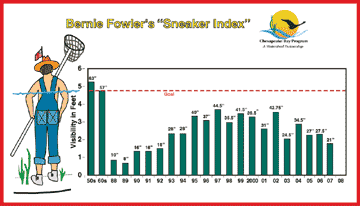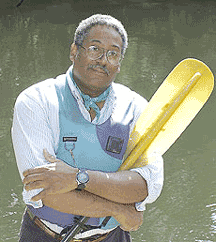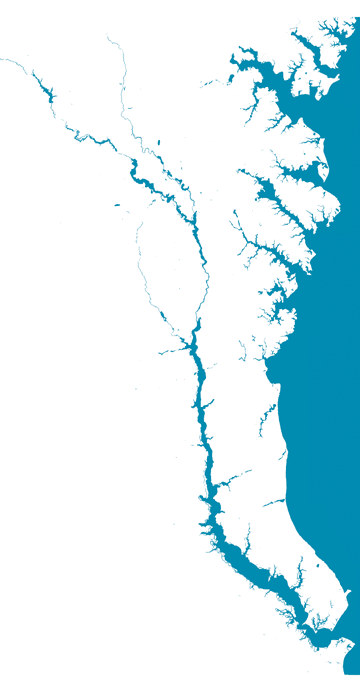Bernie Fowler’s 20th Annual
Patuxent River Wade-In
Many Fans, Few Dollars
by Sandra Olivetti Martin
Bernie Fowler can fill a tent as enthusiastically as a revival preacher.
Several hundred men, women, children and dogs gathered under the yellow-striped tent to hear speeches, songs and promises. Then a long line of them waded into the murky Patuxent River at Broomes Island on the traditional second Sunday in June.
The old state senator can draw a quorum of politicians as reliably as election year.
Gov. Martin O’Malley came as he promised, walking on crutches — as he will for six weeks, after suffering a stress fracture to his left shin bone while running. He waded in, alongside Fowler, to a depth of 21 inches and called for “41 inches next year!”
U.S. Rep. Steny Hoyer, the powerful Maryland congressman who is the majority leader of the U.S. House, kept his pants dry this year, though he did his annual job of taking the measure of Fowler’s wet coverall leg. Maryland Senate President Mike Miller, whose Calvert district covers the lower Patuxent, waded in for the first time, along with new Attorney General Doug Gansler. Sen. Roy Dyson, from lower Calvert and St. Mary’s, waded in for the umpteenth time, linked arm in arm to Del. Sue Kullen and Calvert Commissioner Wilson Parren. Commissioner Susan Shaw kept her feet dry.
Fowler can turn out experts and dignitaries as surely as a gubernatorial summons. Among the pack: Secretary of the Maryland Department of Natural Resources John Griffin; Shari Wilson, secretary of the Maryland Department of the Environment; Hagner Mister, former secretary of the Maryland Department of Agriculture; Donald Boesch, president of the University of Maryland Center for Environmental Science; Michael Smolek, director of Jefferson Patterson Park and Museum; Patuxent Riverkeeper Fred Tutman; Bill Goldsborough, senior scientist at the Chesapeake Bay Foundation; Ralph Eshelman, former head of Calvert Marine Museum and Sherrod Sturrock, the museum’s deputy director; former EPA scientist Kent Mountford; Bay bard Tom Wisner.
But even the redoubtable Fowler, a Maryland icon whose fame has spread round the world, cannot pull dollars out of an empty pocket.
“Did I come here with $200 million prepared to announce I had funds to spare?” queried Gov. Martin O’Malley, rhetorically, as a throng of reporters wondered whether he’d brought money, as well as good words, to Fowler’s 20th Anniversary Wade-in to his beloved, and ailing, Patuxent River.
The governor did not. 
Citing the state’s $1.5 billion deficit and the similar plight of the state’s other rivers, O’Malley asked Fowler and his gathering of followers, as many of their T-shirts proclaimed them, to count the state’s achievements and look ahead to the federal largesse of a “brighter” post-Bush day.
Nor did the other politicians and dignitaries who brought good wishes and moral support bring funds.
Fowler had made no secret of his hope that this 20th anniversary would be his river’s year [Editorial: Bernie’s Patuxent Plea: No Waiting After Wade-In, Vol. xv, No. 23: June 7]. He lobbied the governor hard and long, even as Patuxent water dripped from wet pants legs into wet shoes.
“I was looking for Lady Patuxent to get her accolades,” Fowler acknowledged. “And that didn’t happen.”
Yet he professed himself only “mildly disappointed.”
“I know the governor and his cabinet are working on it,” Fowler said.
Indeed we are, said Natural Resources Secretary Griffin: “We’re starting off by using the Patuxent as the prototype for BayStat.” BayStat is O’Malley’s touted measurement program imported from his years in Baltimore, to, he says, “show us where we [should] allocate money to do the greatest good.”
Poet Tom Wisner, whose words inspired the tradition that’s made such a big splash, gave another reason for “feeling a little more hopeful.”
“I’ve looked at a lot of governors singing that song,” [Chesapeake Born] Wisner told Bay Weekly. “I look in O’MaIley’s eyes, and I see a good heart and soul. I think he will do all anyone can do. That’s all I expect of people.”
The Patuxent’s 11th Hour
Sustainability starts with a plan — not cash
by Carrie Madren
Money may not be flowing toward the Patuxent River as Bernie Fowler had hoped. But loads of money might not solve the river’s problems.
“What would we fund if we had more money?” asks Patuxent Riverkeeper Fred Tutman. “We look for money rather than solutions. A line item doesn’t make the river sustainable. Money becomes the obstacle.”
While the river lacks riches in dollars, it is rich in scientific data.
“People say the Patuxent River is the most studied river in the country,” says Tutman of his charge, which stretches from playful creeks in upper Montgomery County to a mile-and-a-half-wide expanse at Solomons.
At 110 miles long, Maryland’s longest and best documented river is ailing.
“The river’s as bad off as it’s ever been,” Tutman says, contaminated by wastewater treatment output, dumping, nutrients and negligence. To save the Patuxent, before we pass what Fowler calls “the point of no return,” we’ll need to take swift, decisive action soon.
In the Patuxent’s 11th hour, what the river needs most isn’t our money but our dedication. The river needs higher standards for private businesses and lower tolerance for pollution. The river needs our commitment to keep out nutrients and slow stormwater runoff.
But most of all, the river needs a plan.
Though it’s the most studied river, river advocates still have no action plan to clean it up.
“We know what’s wrong, but we can’t seem to get an agreement on what we should be doing,” Tutman says.
“We need a plan that looks at all seven counties on the Patuxent River and the studies, and says here are the clues, and we need to do something about these issues,” Tutman says. A comprehensive strategy would specify benchmarks for success, “to see how we’re doing,” he says. Flexibility would be built in, leaving room to measure and adjust to what works best for farmers, industrialists, residents and everyone else.
Tutman and his Riverkeeper staff are now drafting that much-needed plan. Due out in October at the Patuxent River Appreciation Days, it will be online for comment by August.
“We’re not reinventing the wheel,” Tutman says. “Everything is based on public studies.”
Among the pollution sources the Riverkeeper plan will address: wastewater treatment plants and us.
Of the 36 wastewater treatment plants within the Patuxent watershed, only six are big enough to qualify for flush tax improvements. Even for those six, Tutman says, the flush tax is empowered only to bring them up to design capacity. If they weren’t designed well in the first place, flush fees won’t solve their problems.
“The other 30 get a free pass,” Tutman says. “The state’s not doing anything about those.”
The most incessant pollution comes from people. Dirty effluent flows from our construction sites, industrial sites, landfills, lawns with fertilizer, easily eroded sites and more. “Virtually nothing is being done to ameliorate non-point sources,” Tutman says. A plan would detail ways to curb these pollution sources.
“A plan can be implemented: This is step one, this is step two,” Tutman explains. “Some of the pieces will require money; others are inexpensive changes everyone can make.”
Money is easy, he says. Changing behavior — that’s the hard part.
A New Song for an Old Cause
by Tom Wisner
Poems and songs are my way of trying to wade into the truth. Back in 1984, I wrote a poem called A Guide to Wading Into Southern Maryland Rivers. Tom Horton published it in his Bay Country, and we encouraged Bernie to join with us and make an actual annual event in tribute to his efforts in the legislature to be able to wade out there to see his feet.
It was lots of fun for many of us river advocates to get together once a year and wade and enjoy lifting the vision in this way.
One major flaw in our current practice is in not finding the way to encourage and enable the mass of people to participate. My guess is that no more than 10 percent actually walk in line into the water and then turn and return still holding hands to experience the full ritual of the wade-in. This wade-in is a renewing ritual. If you do it, you will have the experience of being one with the people in the river.
I will go to my grave in support of Bernie in all of his untiring efforts to save and clarify these waters. I have come to have some questions about the process. This year, approaching our 20th wade in, I have become somewhat discouraged with our political process. Sometimes I wonder if ever the process will enable us to open our vision and become as large as Bernie’s good heart would have us become.
Additionally, the concept of the annual wade-in that is in the poem had a hidden tribute. Turkey Tyac, the great Southern Maryland medicine man of the Piscatawa people, taught me in the early 1970s to wade in the river every summer. He said that it was an annual ritual of renewal among his people. I left that concept in the background when I wrote the original poem. So here is my revision:
Tribute to the 20-Year Wade
Old Turkey Ty the Piscatawa
Waded in at summer solstice
He did it to renew his soul
And point a way for most us
So we modeled after Turkey
Year upon each year
To advocate for legislation
To make the river clear
Near 20 years we followed
One another to the edge
Then plunged into the water
To celebrate our pledge
Bingo Bong the scientist
Appeared there many times
To attest to the integrity
And validate these rhymes
No one would dare protest the words
Of the scientist Bingo Bong
For he is a world authority
On the works of river’s song
Politicians marked his words
And repeated them each season
Promising a full return
To sanity and reason
They strutted and they postured
Waxing ever eloquent
’Til they became the story
And we wondered where the river went
EPA folks made up a chart
To keep track of Bernie’s Measure
They called it Sneaker Index
And made his pants the measure
Well many folks have waded
Each year in and each year out
But they know the measure on his britches
Is not what it’s about
It’s not about one person
Leading all the rest
It is about a massive multitude
Gathered in a quest
It’s not about a Democrat
Or a posh Republi-can
It’s not about a Buddhist monk
Or a Baptist preacher man
The story is the river
And people wading hand in hand
To find hope together
For all the waters of our land
The story is the river
Of, by and for … no quarter!
It’s about the folks all gathered up
Of, by and for clean water.
–June 10 2007
